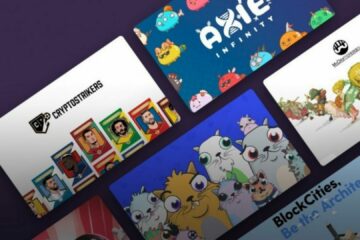Blockchain Technology What role NFTs could play in journalism.
There’s a lot of hype around NFTs. The digital certificates of authenticity are playing an increasingly important role, especially in the art market. But the first media companies are also relying on the new technology. How does it work and how could non-fungible tokens be used in journalism?
What are NFTs?
Blockchain technology has so far not only produced new digital currencies such as Bitcoin, but also the decentralized encryption technology NFT: Non-Fungible Tokens (translated as “non-exchangeable features”) are complicated digital codes with a simple function: to prove authenticity.
Digital works can be copied infinitely, but NFTs are unique. They are logs that record the origin and all transactions of a particular file. NFTs are not stored centrally anywhere, but are located in the blockchain, a decentralized security procedure on which Bitcoin, for example, is based.
So far, NFTs have mainly been used in the art market. In 2021, some NFTs were marketed there for huge sums of money. For example, there was almost $ 70 million for works by the artist Beeples in March. In May, an Internet viral video entitled “Charlie Bit My Finger Again” sold for over $ 760,000 *.
Which media are NFTs already using?
So there is obviously a huge amount of hype surrounding NFTs. And where there is hype, there is a market. And now the first media are involved. Time Magazine sold three of its front pages as NFTs in March 2021. The daily newspaper “USA Today” sells old issues as collector’s items via blockchain.
And at the end of September, the London fashion and lifestyle magazine “Evening Standard” auctioned a work of art for the first time as an NFT. It is a video that shows the British transgender artist and activist Kai-Isaiah Jamal as a living sculpture in a futuristic virtual landscape. You can hear a poem from the pen of Jamal.
The piece went under the virtual hammer on September 24th, 2021 for 1,700 pounds. The “Evening Standard” donates the proceeds to social projects. The buyer now has an unfalsifiable digital certificate stating that the work belongs to him.
The executive director of the “Evening Standard”, Charles Yardley, calls this a historic moment. He speaks of NFTs as an exciting movement from cryptography, media and fashion and dreams of NFT events as advertising campaigns. One could approach Rolex for an NFT about diving – with waterproof wristwatches.
How could NFTs be used in journalism?
If you look through the current hype, NFTs are essentially about something else, says David Cohn, innovation researcher at the US media group Advance: Blockchain and NFTs are about trust and transparency and the digital transfer of knowledge. That is why this technology will eventually change the world of news and information.
Cohn’s idea: In theory, a network for knowledge transfer could also be built on a technology that can safely certify financial transfers and art trade. Not yet, says Cohn – but one should imagine a future in which most people have so-called digital “wallets”. These are digital identities with which you can trade and identify yourself online, such as user accounts, as you know them from online shopping, or from social networks; only that in the case of user accounts, the personal data is held by companies. In the blockchain, trading and communication are decentralized and encrypted.
How realistic is the use of NFTs for journalism?
US innovation researcher David Cohn believes that the future of journalism lies in a kind of Wikipedia, a global social network of information that everyone can participate in. NFTs would then be a possible proof of the quality of the individual knowledge transfers.
That is a utopian scenario. It is also conceivable that NFTs and blockchain will remain irrelevant for the media industry. In any case, media companies would have to be prepared for this scenario to give up ownership of knowledge and personal data and to convert both into common good.
Since Christie’s auctioned an NFT by the hitherto completely unknown graphic designer Beeple for a spectacular 69.3 million dollars in mid-March, the art world has been struggling: with buyers who buy files for insane sums of money, with online platforms that have not yet been associated with the art trade with artists who take their marketing into their own hands.
Only a few galleries have so far wanted to get involved in the art world of the Non Fungible Token, which suddenly appeared, the conventional business aroused. NFT are certificates of authenticity for digital files.
In Cologne, the galleries Nagel-Draxler and Priska Pasquer responded with their own unconventional exhibition concepts. Christian Nagel and Saskia Draxler decided on a multimedia adventure landscape in which visitors can follow in the footsteps of previous and new users of digital art. They hired the American curator and digital artist Kenny Schachter as curator for their show entitled “Breadcrumbs: Art in the age of NFTism”. The exhibition runs until August 21.
Saskia Draxler speaks of a “walkable website” with physical and virtual components. There are texts, painted canvases by artists who also make NFTs, printouts of digital works of art and art on screens according to the various options for making NFTs visible. Because anyone who buys such a data record can print it out and play it out as a digital file in 3D or on a screen.
The NFTs are presented virtually via the OpenSea platform, which works with the Ether blockchain and the associated crypto currency ETH.
Pasquer is more radical and lets her guests take a flying course for a virtual gallery. It is located offshore on an island in the sea; because unlike Nagel-Draxler, the art dealer does not need a physical gallery for the presentation of NFTs.
Pasquer’s “Virtual Gallery”, founded in February, also works in pandemic times. Every visitor can visit the virtual exhibition space, a replica of the upper floor of their former gallery space, as an avatar and talk to other people present.
Unlike NFTs, the exhibits do not necessarily have to be digital in nature, but must be digitized. This means that physical exhibitions can also be recreated in the virtual gallery and viewed virtually.
Flying over the island can be a bit of a hassle, depending on the browser type. But flying is a must. Because the NFT exhibits are attached to supports in the sea outside the gallery and look like giant billboards. The gallery itself has brought nature back. Plants overgrow the architecture. The physical gallery concept is not a place for the new, purely digital practice of the NFTs, Pasquer wants to signal with it.
Pasquer is more radical and lets her guests take a flying course for a virtual gallery. It is located offshore on an island in the sea; because unlike Nagel-Draxler, the art dealer does not need a physical gallery for the presentation of NFTs.
Pasquer’s “Virtual Gallery”, founded in February, also works in pandemic times. Every visitor can visit the virtual exhibition space, a replica of the upper floor of their former gallery space, as an avatar and talk to other people present.
Unlike NFTs, the exhibits do not necessarily have to be digital in nature, but must be digitized. This means that physical exhibitions can also be recreated in the virtual gallery and viewed virtually.
Neither Pasquer nor Nagel-Draxler make headlines with sales in the millions. Even the eagerly awaited, freshly minted works of the highly sought-after DotPigeon represented by Nagel-Draxler are currently at 4,444 ether. At the time of going to press, that corresponds to 8,200 dollars. Eva Beresin’s animated painting with a mouse that disappears into the wide open throat of a bald man cost three ethers or the equivalent of 5536 dollars.



0 Comments